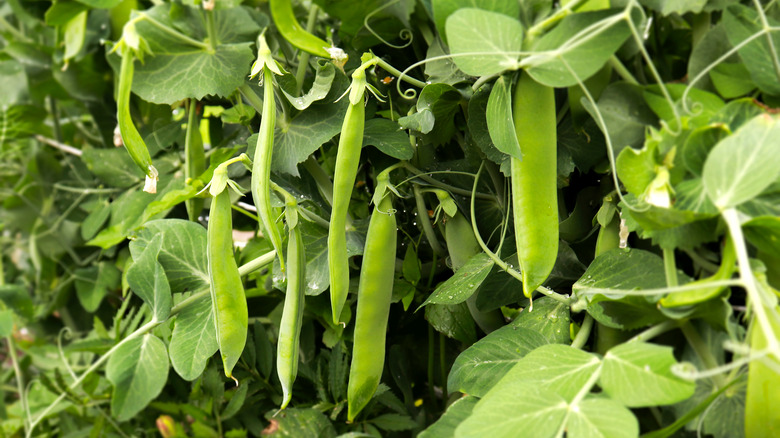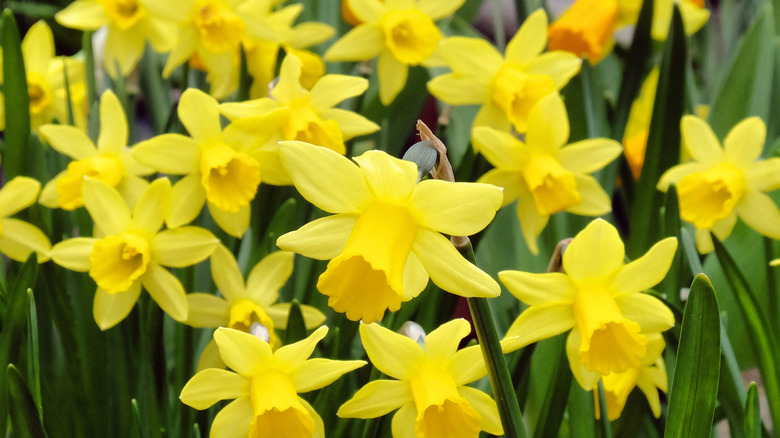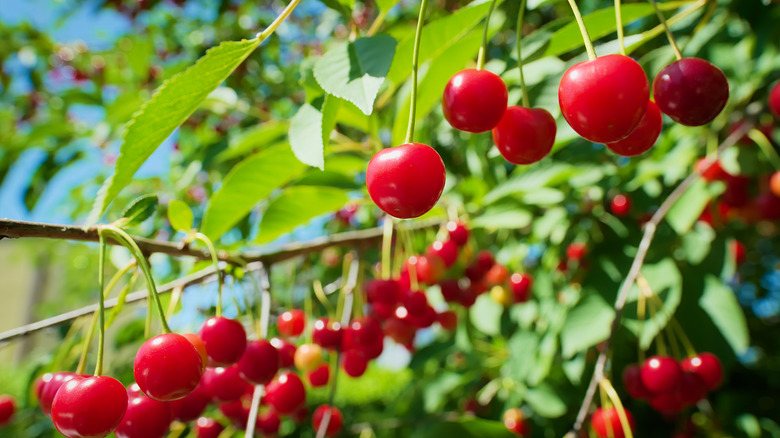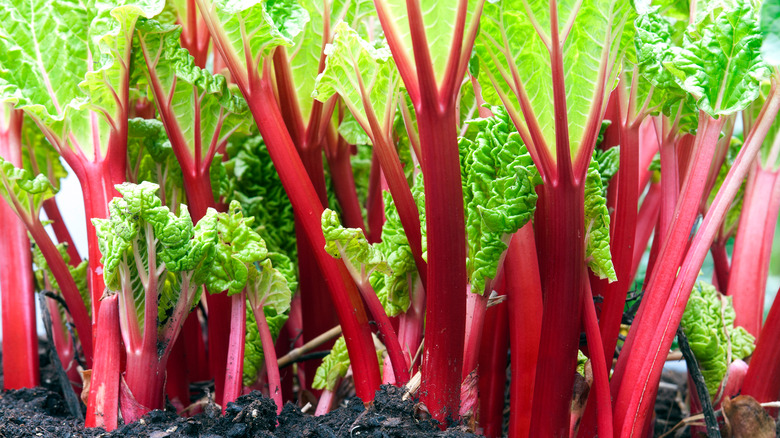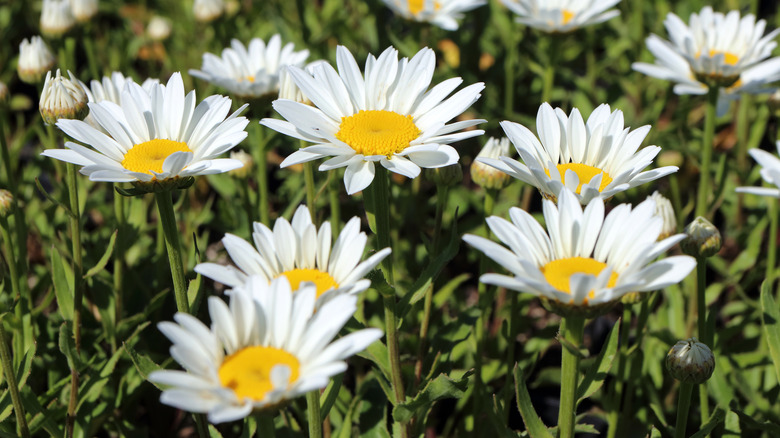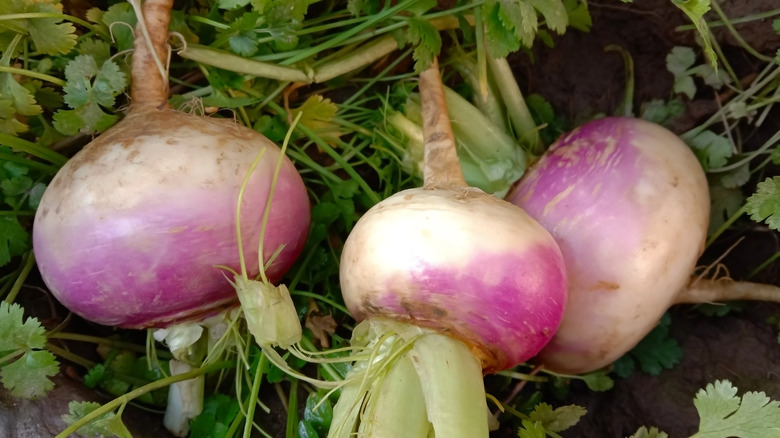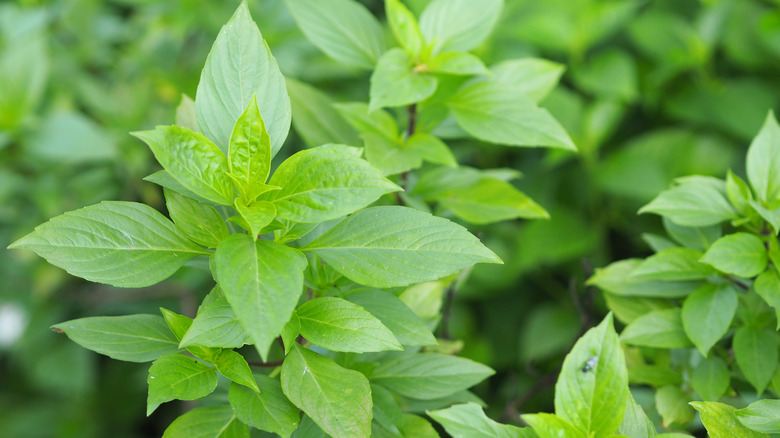15 Plants Perfect For An English Cottage Garden
Visions of Victory Gardens and Mary Poppins may dance in your head when you think about what constitutes a proper English cottage garden. But what distinguishes the garden of a loyal subject of the crown from an otherwise well-tended plot of ground is composition. Thought goes into every decision and guides every execution from planting to pruning and beyond. That's because when these cottages first came into use hundreds of years ago, they were the household's supermarket — not only containing herbs and foodstuffs but with domesticated livestock wandering the premises too.
Everywhere you look in one of these gardens, according to The Middle-sized Garden, nature is given primacy, with daily nudges from a constant gardener. The most picturesque will contain a lawn, divided by one or more paths, the obligatory roses accompanied by flowers of the season, topiary, and man-made objects like trellises, rose arches, and the occasional pond or gazebo.
But the less idyllic and more realistic cottage garden creates an environment that is at once rustic and almost haphazard, an anything-goes hodgepodge of the edible and the floral. In other words, there's no expense spared — at least in terms of manpower — to make an English cottage garden appear absolutely effortless, even if the truth is something else entirely.
If you're thinking of incorporating some ideas from the classic English cottage garden or even considering creating one of your own, here's a list of 15 plants you could expect to find while strolling the grounds.
1. Roses
Flowers are a cornerstone of the British traditional garden, says Monrovia, and any resemblance to a cottage in the English countryside would be lost without the liberal inclusion of roses among them. Generally speaking, there are three types: modern roses, wild roses, and old garden roses. Today's gardens most often feature modern roses, which have been engineered to present large blooms throughout the growing season.
Bloom Seasons: Spring, summer, and fall
USDA Growing Zones: 4 through 11, depending on the rose, according to David Austin
Growing Conditions: Full sun
Soil Type: Barely acidic to neutral
Size: Varies by species
2. English peas
English Peas (Pisum sativum) add luster you can eat. Because their tough pods are undigestible for humans, they must be shelled — which many regard as a zen activity akin to gardening. The Wandering Chopsticks chefs will tell you they're central to English cottage pie recipes. These are actually the same peas most often shelled and packaged frozen for sale in supermarkets — and they'll continue to grow by smaller increments until you harvest them.
Bloom Season: Harvest-ready 55-80 days from planting
USDA Growing Zones: 3 to 11
Growing Conditions: Sun to partial shade
Soil Type: Loamy
Size: Bushy, prunable
3. Daffodils
Daffodils (Narcissus) actually refer to roughly 50 species of perennials, according to the Missouri Botanical Garden. These typically display blooms in the form of cups or trumpets. They are poisonous to animals but have been used as medicine for humans, according to WebMD. They grow best where the surroundings are unmown — perfect for a cottage garden. Their colors range from white to pink, yellow, and orange.
Bloom Season: Late winter, early spring
USDA Growing Zones: 3 to 8
Growing Conditions: Partial to full sun
Soil Type: Neutral to acidic
Size: Anywhere between 8 and 16 inches tall
4. Dwarf cherry tree
Dwarf cherry trees (Prunus fruticosa) are an eye-popping addition to any garden since UK cottages typically combine edibles with florals. Gurney's reports that these trees are renowned for their deep luscious color, high levels of sugar, and overall hardiness. And bonus: they're cold-resistant and generate more fruit (the flesh-to-pit ratio) than most cherries.
Bloom Season: March through early April
USDA Growing Zones: 2 through 7
Growing Conditions: Sunny, with circulating air
Soil Type: Typically moist, well-draining
Size: 5 to 8 feet high
5. Yarrow
Not only does Yarrow (Achillea millefolium) bloom with delicate flower clusters of pink, yellow and red, it can easily turn your garden into a butterfly sanctuary, according to Almanac. The plant also has medicinal uses (Native Americans put it to work as a sunburn reliever) and was nicknamed "Carpenter's Weed" because it's been used for generations to stop bleeding from the cuts and wounds encountered by woodworking artisans.
Bloom Season: July through September
USDA Growing Zones: 3 to 9
Growing Conditions: Full sunshine
Soil Type: well-draining soil, never wet
Size: 2 to 4 feet tall
6. Rhubarb
Rhubarb (scientific name Rheum rhabarbarum) is a vegetable, not a fruit. It's also not naturally sweet but tart. In fact, the redder they are, the more tart they become. Originally, rhubarb was valued for its success as a laxative and its ability to relieve intestinal gas. It's also noted for its vitamin A content, which combats free radicals, according to Web MD.
Bloom Season: Spring
USDA Growing Zones: 3 to 8
Growing Conditions: Partial to full sunshine
Soil Type: depends on the variety
Size: 2 to 3 feet tall — and wide, as well
7. English lavender
English Lavender (Lavandula angustifolia) is a fragrant and frequent component of many an English cottage garden. Not only are they an aromatic contribution to the grounds, but they also add a serious wow factor when in bloom. Ancient Egyptians used lavender to offset the scent of corpses during mummification, according to TUMALO Lavender, and the Greeks used it to treat indigestion and headaches.
Bloom Season: Summer
USDA Growing Zones: 5 through 10
Growing Conditions: Full sunshine
Soil Type: Well-draining
Size: Between 1 and 3 feet tall
8. Kale
Kale (Brassica oleracea) is without question one of the most nutritious foods you can grow. On the table, it's great in salads and is loaded with antioxidants and vitamins. You can also make kale chips with recipes like this one from allrecipes. In your yard, say the experts at Almanac, kale is robust enough to withstand frost and snow.
Bloom Season: Variety dependent
USDA Growing Zones: 7 through 9
Growing Conditions: Partial to full sunshine
Soil Type: Neutral to slightly alkaline
Size: 1 to 2 feet
9. Peonies
Peony (genus Paeonia) describes some 30 species of plants, according to Plant Snap, renowned for their large and dramatic blossoms. Even more impressive is the fact that peonies, unlike people, are often still fertile well past the century mark. As a plant, peonies are tucked into the dense and lush foliage that provides much of the simple beauty a cottage garden evokes.
Bloom Season: Spring, summer
USDA Growing Zones: 3 through 8
Growing Conditions: Full sunshine
Soil Type: Neutral
Size: 2 to 3 feet tall
10. Damson fruit
Damsons (Prunus insititia) are purplish-blue drupes so similar to plums that it's hard to distinguish which is which. The authorities at Arbor Day say the biggest difference is in damsons' more tart flavor. For unknown reasons, damsons have not caught on globally as plums have. They remain —not exclusively, but primarily — in Great Britain.
Bloom Season: August through early fall
USDA Growing Zones: 5 through 7
Growing Conditions: Full sunshine
Soil Type: Loamy, well-draining soil that could be mildly alkaline to mildly acidic
Size: 20 feet, half that if you've selected a dwarf variety
11. Daisies
The snowcap shasta daisy is one of the signature flowers in many English cottage gardens. Why else would Mary Poppins favor them so? These are as dazzling as they are hearty, resistant to drought, humidity, and heat, according to Monrovia, and they're irresistible to butterflies as well. As a cultivar, these daisies, in particular, appear in such dense clumps that they support each other against the elements.
Bloom Season: Late spring through early fall, zone depending
USDA Growing Zones: 4 through 9
Growing Conditions: Full sunshine
Soil Type: Neutral
Size: 10 to 14 inches tall
12. Turnips
Turnips (Brassica rapa subspecies rapa) have been feeding humanity since the Romans ruled Europe. Often, they're thought of as related to beets or potatoes since they're often cooked in similar ways, but the truth is they're more closely related to radishes, and they're all part of the mustard family. According to New World Encyclopedia, there are now more varieties than ever.
Bloom Season: Harvest depends on growing conditions
USDA Growing Zones: 9 and 10
Growing Conditions: Full sunshine
Soil Type: Slightly acidic to neutral
Size: 12 to 15 inches tall
13. Zinnias
Zinnias (Zinnia sp.) are an easy way to add a range of colors to your garden. They're strong-stemmed, drought and heat tolerant, and grow quickly from seed to flower to seeding, according to Almanac. Many gardeners simply toss seeds where they'd like zinnias to grow. Because all that's true, these flowers also crowd out weeds.
Bloom Season: Summer/fall
USDA Growing Zones: 3 through 10, according to Create and Find
Growing Conditions: Full sunshine
Soil Type: Neutral to slightly alkaline or slightly acidic
Size: Anywhere from 4 to 48 inches
14. Sweet basil
Sweet basil (Ocimum basilicum) is, as the horticulturists at Gardener's Path say, among the most cherished of rustic plants for any garden. It's a signature ingredient of innumerable Italian dishes since it's imbued with notes of anise and clove, according to NYBG. There are other relatives worth trying, too, including purple basil (which blooms in pink flowers), lemon, cinnamon, lime, and a minty African blue basil — many of which are used in Thai recipes.
Bloom Season: Summer
USDA Growing Zones: 10 and 11
Growing Conditions: Full sunshine
Soil Type: Neutral to slightly acidic
Size: 12 to 24 inches tall
15. Hollyhocks
Hollyhocks (Alcea rosea) are now available in colors that range from white to pink and yellow, including reds and a midnight burgundy. They're related to the hibiscus, according to Britannica, and do well in areas considered too dry for most flowering plants. While they don't pack much flavor, they are edible. Some cultivars are more delicate than others; many will require staking.
Bloom Season: Summer
USDA Growing Zones: 2 through 10
Growing Conditions: Full sunshine
Soil Type: Rich, moist soil
Size: 3 to 9 feet tall


